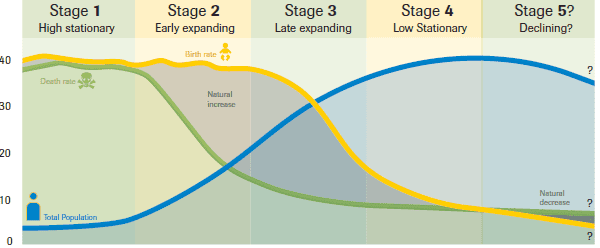What Best Describes the Current Growth of China's Population
The overall trend of Chinas population distribution is very uneven. If current trends continue Chinas population will peak at 144 billion in 2029 before entering unstoppable decline according to a Chinese Academy of Social Sciences study released in January.

Population Of China 2050 Populationpyramid Net
The year 1980 in China is well known as the beginning of the countrys one-child policy.

. Population Another component of Chinas ascent is a massive urbanization. The bigger problem for China is that an aging population feeds into an existing issue. Age groups 11 years old were not greater than those in the 12-year-old age group.
The policy was introduced in China in 1976 after the two-child policy. Analysts at JPMorgan see Chinas growth potential slowing to 55 percent from the current rate of 65 percent between 2021 and 2025 falling further to 45 percent by. It caused employment problems and slowed increases in living standards and educational levels.
Eight major cities support more than two million inhabitants but three-fourths of the population live in the rural areas6 The population is distributed with more than 400 people per square kilometer in the coastal areas and the east and more sparsely populated in the plateau areas in the west with fewer than 10 people per square kilometer7 Chinas population is growing at. So this means that most if not all of the east coast is densely populated. Chinas current population is 1368 billion people but the distribution is very unique 94 of their population are located in the east coast alone while the other 6 are in the west.
In urban centres in China poverty has been virtually eliminated. The UN projected population to keep growing and estimates have put the total population at 86 billion by mid-2030 98 billion by. Global human population growth amounts to around 83 million annually or 11 per year.
Population growth. China has a population growth rate of 056 the worlds 159th highest. The Chinese economy is still growing and growing quickly by many standards its 66 percent.
However population growth is a factor that can be managed. The 1964 pyramid shows that the number 11 years old was still increasing which reflects a growing population since 1943 and 1953. By some estimates the number of urban middle-class households in Chinadefined as those earning between USD9000 and USD34000 a yearwill increase from just 4 percent in 2000 to 76 percent or more than 550 million people by 2022.
The growth rate of the population 10 years old was higher than the population 10 years old and higher than the growth rate in 1943. Roughly half 47 of Chinas current population were born under the policy ages 0 to 34 today and they lived through a very different. Human population planning is a means of intentionally controlling the human population growth rate.
The relative growth in productivity is another factor behind the meteoric rise in GDP per capita of China. This has fuelled further industrialisation allowing for further population growth. The global population has grown from 1 billion in 1800 to 79 billion in 2020.
According to the government the total fertility rate was 13 children per woman. The male population accounts for 5129 of the total population while the females make up 4871. The best way to control population growth is based on a.
The rapid population growth rate 2 annually from 1949 to 1978 caused great difficulties for Chinas national economy because it increased the burden of families communities and government. The 2019 projections from the United Nations Population Division made before the COVID-19 pandemic show that annual world population growth peaked at 21 in 1968 has since dropped to 11 and could drop even further to 01 by 2100 which would be a growth rate not seen since pre-industrial revolution days. Rapid population growth in China despite the One Child Policy has resulted in very large numbers in the economically active population leading to rapid urbanisation.
For years Chinas ruling Communist Party implemented a series of policies intended to slow the growth of the worlds most populous nation including limiting the number of children couples. A research institute affiliated with real estate giant Evergrande Group last week issued a study saying the government figure was an overestimate and recommended that three children be allowed. China experienced an average GDP growth of close to 10 per year until 2014 raising per capita GDP almost 49-fold from 155 current US Dollars 1978 to 7590 US Dollars in 2014 lifting 800 million people out of poverty an unparalleled achievement.
Slower growth in labor productivity said Alicia. Some Chinese officials blame the declining work force for the countrys declining economic growth. However a high population overpopulation can also be considered a threat to the environment and resources.
But what may be overlooked is how that year also marked a turning point in Chinas generational experiences. Population growth is the increase in the number of people in a population. The government estimates the 2020 census could update the population to 142 billion a 599 percent increase.
Africa is expected to have the strongest population growth of any world region in the next 80 years according to Lopez. The continents total population will grow 13 to. The birth rate is 117 births per 1000 while the death rate stands at 73 deaths per 1000.
According to his projection Chinas population could reach 15 billion by 2020 which was viewed as a disaster that could be avoided only by quickly adopting a one-child policy.

Animation How The Demographics Of China And India Are Diverging

Evr Chapter 6 Flashcards Quizlet

Stage 2 Of The Demographic Transition Model Population Education
0 Response to "What Best Describes the Current Growth of China's Population"
Post a Comment